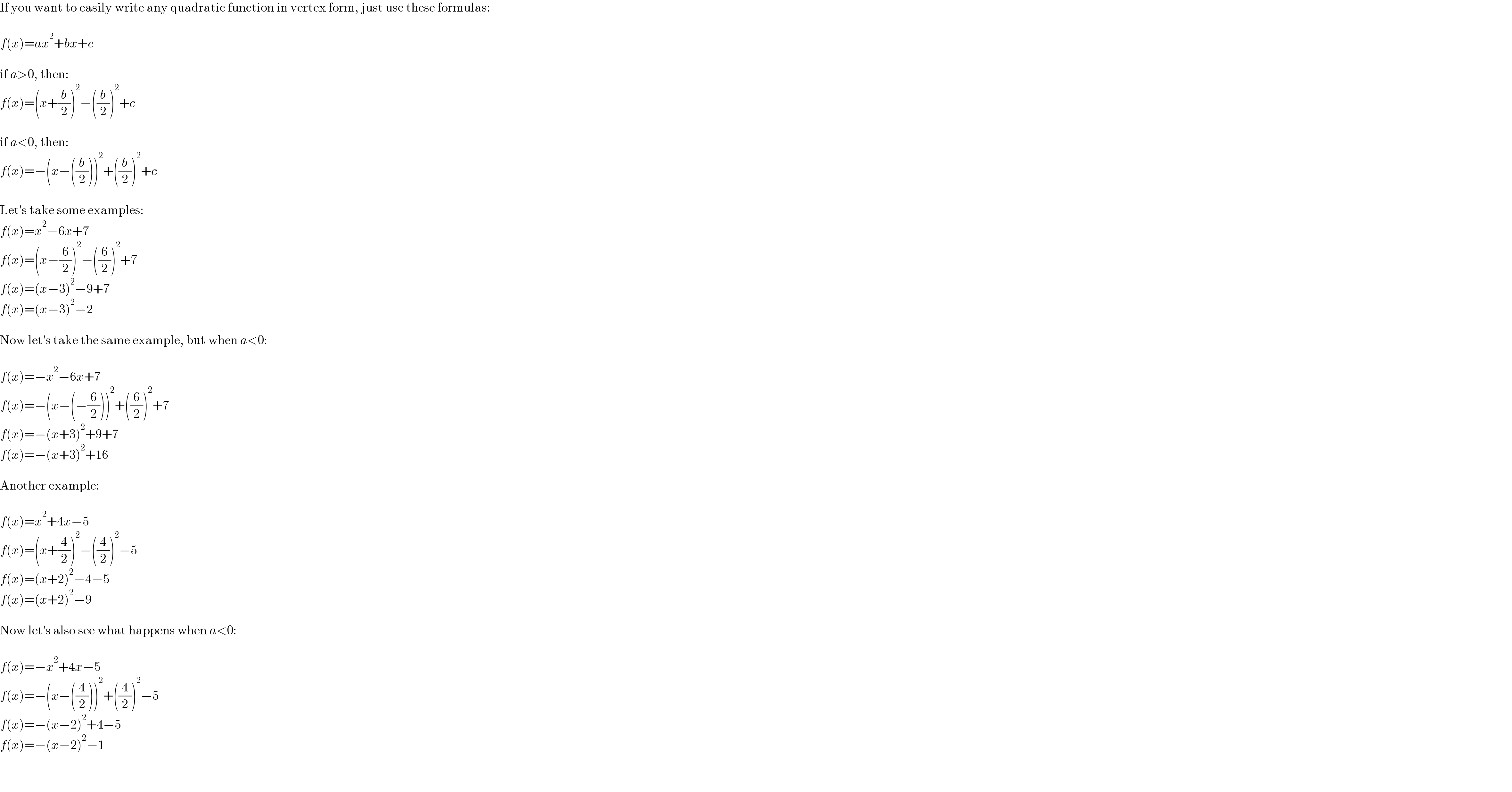Question Number 157053 by depressiveshrek last updated on 19/Oct/21

$$\mathrm{If}\:\mathrm{you}\:\mathrm{want}\:\mathrm{to}\:\mathrm{easily}\:\mathrm{write}\:\mathrm{any}\:\mathrm{quadratic}\:\mathrm{function}\:\mathrm{in}\:\mathrm{vertex}\:\mathrm{form},\:\mathrm{just}\:\mathrm{use}\:\mathrm{these}\:\mathrm{formulas}: \\ $$$$\: \\ $$$${f}\left({x}\right)={ax}^{\mathrm{2}} +{bx}+{c} \\ $$$$\: \\ $$$$\mathrm{if}\:{a}>\mathrm{0},\:\mathrm{then}: \\ $$$${f}\left({x}\right)=\left({x}+\frac{{b}}{\mathrm{2}}\right)^{\mathrm{2}} −\left(\frac{{b}}{\mathrm{2}}\right)^{\mathrm{2}} +{c} \\ $$$$\: \\ $$$$\mathrm{if}\:{a}<\mathrm{0},\:\mathrm{then}: \\ $$$${f}\left({x}\right)=−\left({x}−\left(\frac{{b}}{\mathrm{2}}\right)\right)^{\mathrm{2}} +\left(\frac{{b}}{\mathrm{2}}\right)^{\mathrm{2}} +{c} \\ $$$$\: \\ $$$$\mathrm{Let}'\mathrm{s}\:\mathrm{take}\:\mathrm{some}\:\mathrm{examples}: \\ $$$${f}\left({x}\right)={x}^{\mathrm{2}} −\mathrm{6}{x}+\mathrm{7} \\ $$$${f}\left({x}\right)=\left({x}−\frac{\mathrm{6}}{\mathrm{2}}\right)^{\mathrm{2}} −\left(\frac{\mathrm{6}}{\mathrm{2}}\right)^{\mathrm{2}} +\mathrm{7} \\ $$$${f}\left({x}\right)=\left({x}−\mathrm{3}\right)^{\mathrm{2}} −\mathrm{9}+\mathrm{7} \\ $$$${f}\left({x}\right)=\left({x}−\mathrm{3}\right)^{\mathrm{2}} −\mathrm{2} \\ $$$$\: \\ $$$$\mathrm{Now}\:\mathrm{let}'\mathrm{s}\:\mathrm{take}\:\mathrm{the}\:\mathrm{same}\:\mathrm{example},\:\mathrm{but}\:\mathrm{when}\:{a}<\mathrm{0}: \\ $$$$\: \\ $$$${f}\left({x}\right)=−{x}^{\mathrm{2}} −\mathrm{6}{x}+\mathrm{7} \\ $$$${f}\left({x}\right)=−\left({x}−\left(−\frac{\mathrm{6}}{\mathrm{2}}\right)\right)^{\mathrm{2}} +\left(\frac{\mathrm{6}}{\mathrm{2}}\right)^{\mathrm{2}} +\mathrm{7} \\ $$$${f}\left({x}\right)=−\left({x}+\mathrm{3}\right)^{\mathrm{2}} +\mathrm{9}+\mathrm{7} \\ $$$${f}\left({x}\right)=−\left({x}+\mathrm{3}\right)^{\mathrm{2}} +\mathrm{16} \\ $$$$\: \\ $$$$\mathrm{Another}\:\mathrm{example}: \\ $$$$\: \\ $$$${f}\left({x}\right)={x}^{\mathrm{2}} +\mathrm{4}{x}−\mathrm{5} \\ $$$${f}\left({x}\right)=\left({x}+\frac{\mathrm{4}}{\mathrm{2}}\right)^{\mathrm{2}} −\left(\frac{\mathrm{4}}{\mathrm{2}}\right)^{\mathrm{2}} −\mathrm{5} \\ $$$${f}\left({x}\right)=\left({x}+\mathrm{2}\right)^{\mathrm{2}} −\mathrm{4}−\mathrm{5} \\ $$$${f}\left({x}\right)=\left({x}+\mathrm{2}\right)^{\mathrm{2}} −\mathrm{9} \\ $$$$\: \\ $$$$\mathrm{Now}\:\mathrm{let}'\mathrm{s}\:\mathrm{also}\:\mathrm{see}\:\mathrm{what}\:\mathrm{happens}\:\mathrm{when}\:{a}<\mathrm{0}: \\ $$$$\: \\ $$$${f}\left({x}\right)=−{x}^{\mathrm{2}} +\mathrm{4}{x}−\mathrm{5} \\ $$$${f}\left({x}\right)=−\left({x}−\left(\frac{\mathrm{4}}{\mathrm{2}}\right)\right)^{\mathrm{2}} +\left(\frac{\mathrm{4}}{\mathrm{2}}\right)^{\mathrm{2}} −\mathrm{5} \\ $$$${f}\left({x}\right)=−\left({x}−\mathrm{2}\right)^{\mathrm{2}} +\mathrm{4}−\mathrm{5} \\ $$$${f}\left({x}\right)=−\left({x}−\mathrm{2}\right)^{\mathrm{2}} −\mathrm{1} \\ $$$$\: \\ $$
Commented by Tawa11 last updated on 19/Oct/21

$$\mathrm{Great}\:\mathrm{sir} \\ $$
Commented by MJS_new last updated on 19/Oct/21

$$\mathrm{and}\:\mathrm{if}\:{a}\neq\pm\mathrm{1}? \\ $$$$\mathrm{i}.\mathrm{e}.\:{a}=−\mathrm{3}\:\mathrm{or}\:{a}=\mathrm{7} \\ $$
